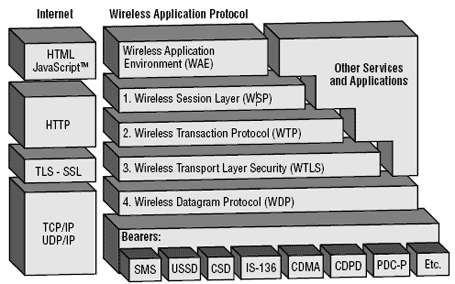
- Wireless Communication - Home
- Wireless Communication - Overview
- Terms in Mobile Telephony
- Multiple Access
- Channel Characteristics
- Wireless Communication - TCP/IP
- Cellular Wireless Networks
- Propagation Losses
- Techniques
- Wireless Communication - WAN
- Bluetooth
- Wireless Communication - Internet
- Wireless Communication - WAP
- Wireless Communication - Satellite
Wireless Communication - WAP
WAP stands for Wireless Application Protocol. WAP represents a suite of protocols rather than a single protocol. WAP aims at integrating a simple lightweight browser also known as a micro-browser into handheld devices, thus requiring minimal amounts of resources such as memory and CPU at these devices.
WAP tries to compensate for the shortfalls of the wireless handheld devices and the wireless link by incorporating more intelligence into the network nodes such as the routers, web servers, and BSs.
The primary objectives of the WAP protocol suite are the following.
- Independence from the wireless network standards
- Interoperability among service providers
- Overcoming the shortfalls of the wireless medium
- Overcoming the drawbacks of handheld devices
- Increasing efficiency and reliability
- Providing security, scalability, and extensibility
The WAP Model
WAP adopts a client-server approach. It specifies a proxy server that acts as an interface between the wireless domain and core wired network. This proxy server, also known as a WAP gateway, is responsible for a wide variety of functions such as protocol translation and optimizing data transfer over the wireless medium.
Wireless network parts consist of −
- Content provider (Application or origin server)
- Mobile device (WAP client)
- WAP gateway
- WAP proxy
The WAP Architecture has been designed to closely follow the web. The only difference is the presence of the WAP gateway is translating between HTTP and WAP.
WAP Client
The three sections to be mentioned regarding WAP client are WAE user agent, WTA user agent and WAP stack.
WAE user agent − Wireless application environment user agent is the browser that renders the content for display.
WTA user agent − Wireless telephony application agent receives compiled WTA files from WTA server and executes them.
WAP stack − WAP stack allows the phone to connect to the WAP gateway using the WAP Protocols.
Application Server
The element in the network where the information (web, WAP) applications reside are WAP proxy, WAP gateway or WAP server −
Proxy − This is an intermediary element acting both as a client and as a server in the network it is located between client and server. The client sends requests to it and it retrieves and caches the information needed by contacting the origin Server.
Gateway − This is an intermediary element usually used to connect two different types of networks.
WAP Gateway is basically software that is placed between a network that supports WAP and IP packet network such as Internet.
The WAP Protocol Stack
WAP protocol stack is shown in the following figure −

Application Layer
The application layer provides an application environment intended for the development and execution of portable application and services WAE consists of two different user agents located on client side.
The WAE user agent consists of browser and the text message editor along with the WTA user agent.
Session Layer
The session layer supplies methods for the organized exchange of content between Client/Service applications.
WAP contains the following components −
Connection Oriented Session Services − These operate over WTP.
Connectionless Session Services − These operate directly over WDP.
Session services − These functionalities help to set up a connection between a client and server using primitive messages.
Primitives messages are defined as messages that client sends to the server to request a service facility. The client sends request primitives and receive confirm primitive and the server can send response primitives and receive indication primitives.
The connectionless session service provides only non-confirmed service. To start session, the client invokes a WSP primitives that provide some parameters, such as the server address, client address and client headers. In some respects, WSP is basically a binary form of HTTP.
Transaction Layer
Provides different methods for performing transaction to varying degree of reliability.
Security Layer
Optional layer that provides, when authentication, privacy and secure connection is present, between applications. It is based on SSL (Secure Socket Layer). It provides services that ensure privacy, server authentication, client authentication and data integrity.
A Standard SSL session is opened between the web server and the WAP gateway, and WTLS session is initialized between the gateway and the mobile device. The encrypted content is send through this connection from the server to the gateway, which translates it and sends it to mobile phone. The transaction between SSL and WTLS takes place in the memory of the WAP gateway.
Transport Layer
This is the bottom layer, connected with the bearer service offered by the operator. Bearer services are the communication between the mobile phone and the base stations. They include SMS, CSD, USSD, GSM, GPRS, DECT, CDMA, FDMA, and TDMA.
The physical layer prepares the data to be sent from the mobile device over the air services and sends the data using bearer service implemented in the network that the device is operating in. WDP has an interface with various bearer networks, so it must have a bearer specific implementation. WDP is the only layer that must be rewritten to support different bearer networks. The WTP layer implements a simple request-response transaction oriented protocol instead of the three-way-handshake connection mechanism.